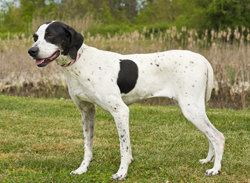Pointers have short coats that come in lemon, liver, black, and orange. They may be solid-colored or come in combination with white. The shiny coat is smooth, dense, and short. Dogs with darker coats have black or brown noses, while dogs with lighter coats generally have flesh-colored noses. The eyes are dark and round, and the ears are jaw-length. Pointers measure 23 to 28 inches tall at the shoulder and weigh 44 to 75 pounds.
Although they tend to be calm indoors, they can become boisterous and even destructive without regular exercise. Mischievousness is another trait common in this breed, and some tend to be protective of their home and family.
Even-tempered, alert, and congenial, Pointers make good family companions for active people. These dogs require very little grooming, but they do need regular exercise and mental stimulation to remain happy and healthy. They are loyal, intelligent, protective, and playful, and they make a great addition to homes with children.
Pointers were the first true pointing dogs, but they were not officially recognized by the AKC until 1884, more than 200 years after the breed first appeared.
Pointers are sweet, affectionate, and gentle dogs that crave human companionship and attention. Although they tend to be calm indoors, they can become boisterous and even destructive without regular exercise. Mischievousness is another trait common in this breed, and some tend to be protective of their home and family.
These dogs are a high-energy breed and need plenty of room to run around. They also benefit from daily walks and activities that provide both mental and physical stimulation, such as constructive tasks and puzzle toys. Pointers enjoy accompanying their human family members on run and hikes, but they should always be kept on a leash for their own safety.
Friendly around most people and other animals, some pointers are reserved around strangers. They are not naturally timid, however. These dogs typically get along with cats they are raised with, but outside cats may become hunted game.
Pointers are a relatively healthy breed, but that does not guarantee than any individual dog will be free of serious health problems or genetic disease. Adopting or purchasing one of these dogs from a reputable source is a good first step in ensuring a long and healthy life.
Health conditions known to affect Pointers include skin allergies, congenital hip dysplasia, epilepsy, and hypothyroidism, a hormonal disorder of the thyroid gland. Heart problems, such as aortic stenosis, are also seen in the breed, and these dogs are at increased risk for certain eye conditions, including progressive retinal atrophy, entropion, and cataracts. Additionally, congenital deafness and tail-tip injuries are seen more often in Pointers than in some other breeds.
Pointers typically live up to 15 years, provided they receive routine veterinary care, a healthy diet, regular exercise, and timely vaccinations.
Consistency and firmness are key when it comes to training Pointers. These dogs are hardheaded and stubborn, but they are also highly intelligent and learn quickly. Positive reinforcement, such as praise, play, and food rewards, and consistent commands will go a long way toward ensuring success.
If pushed too far, harshly criticized, or punished, these dogs may shut down or regress. This can slow or even stop training success. Rewarding Pointers for positive behavior and progress will keep training moving in the right direction.
Like with other dogs, early socialization will help ensure the Pointer grows into a confident and tolerant adult. Puppy kindergarten classes are great early in life, and regular trips to the dog park combined with walks around town and to neighborhood businesses will ensure continued tolerance throughout life.
Pointers are generally easy to groom; they don't require much brushing or bathing and they shed minimally. Brushing the coat every two or three days is enough to distribute skin oils and remove any loose hairs that would otherwise end up clothing and furniture. A rubber curry brush works well on these dogs. Rubbing the coat with a chamois will add shine.
Bathing these dogs is rarely necessary unless it is to remove a harmful, stinky, or sticky substance from the skin or coat. A gentle shampoo made specifically for dogs will clean the coat without drying out the skin.
The nails need clipping every couple of weeks to prevent painful and dangerous snags and breaks, and the ears should be checked once or twice weekly for signs of infection. Pointers need their teeth brushed every day with a canine toothpaste and toothbrush. Failure to do so increases the risk of gum disease and tooth loss.
The first known appearance of the Pointer was in England around 1650. The breed was the first to stand game. These dogs were used to locate and point small game in conjunction with Greyhound coursing.
Likely originating from a combination of setting spaniel, Bloodhound, Foxhound, and Greyhound, the Pointer was first brought to America before the Civil War. The result of this crossing resulted in the creation of the first true pointer, or a hunting dog that points to its game when it finds it.
During the 1800s, the breed was crossed with setters to improve its disposition and trainability, and when dog shows became popular during the late 19th century, Pointers were some of the most prominent of the breeds shown. Today, Pointers remain popular as recreational hunters and competitive field trial dogs. They enjoy limited popularity as companion animals.
The American Kennel Club officially recognized the Pointer in 1884.

